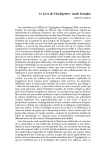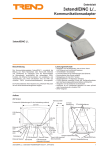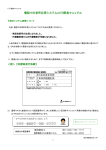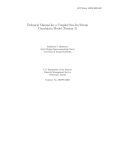Download User's Guide for TWPBVP: A Code for Solving Two
Transcript
User’s Guide for TWPBVP: A Code for Solving Two-Point Boundary Value Problems 1 J. R. Cash Margaret H. Wright Department of Mathematics AT&T Bell Laboratories Imperial College Murray Hill, New Jersey London, England USA e-mail: [email protected] e-mail: [email protected] Introduction The code TWPBVP (written in Fortran 77) is designed for the numerical solution of the two-point boundary value problem du = f (x, u), dx gi (u(a)) = 0, i = 1, . . . p; a ≤ x ≤ b, gi (u(b)) = 0, (1) i = p + 1, . . . , n, (2) where x ∈ R, u ∈ Rn , gi ∈ R for 1 ≤ i ≤ n, and 0 ≤ p ≤ n. The functions f and {gi } are assumed to be differentiable. The method used in TWPBVP is a deferred correction method based on monoimplicit Runge-Kutta formulas and adaptive mesh refinement. For details about the method, see [Cash86, Cash88, CW90, CW91]. Two aspects of the formulation (1)–(2) should be noted: 1. The problem must be posed as a first-order system. This requirement is not unduly restrictive, however, since standard techniques can be used to convert an nth-order equation to a system of n first-order equations. For example, the second-order problem y 00 = f (x, y, y 0 ), 0 ≤ x ≤ 1, y(0) = α, y(1) = β, can be converted to the following first-order system: u0 = z z 0 = f (x, u, z) u(0) = α u(1) = β. 2. The boundary conditions must be separated. TWPBVP allows all the boundary conditions to be imposed at one end of the interval [a, b], so that initial value problems are handled as a special case. It is hoped to extend TWPBVP to handle non-separated boundary conditions; see [AMR88] for a discussion of techniques that allow some non-separated boundary conditions to be converted to the separated form needed here. 2 Formal parameters The calling sequence for TWPBVP is 2 2 * * * * * FORMAL PARAMETERS subroutine twpbvp(ncomp, nlbc, nucol, aleft, aright, nfxpnt, fixpnt, ntol, ltol, tol, linear, givmsh, giveu, nmsh, xx, nudim, u, nmax, lwrkfl, wrk, lwrkin, iwrk, fsub, dfsub, gsub, dgsub, iflbvp) We now describe the formal parameters. ncomp - Integer, input. ncomp is the number of first-order differential equations (n in (1)), and is the number of components of u at each mesh point. ncomp must be positive. nlbc - Integer, input. nlbc is the number of boundary conditions at the left endpoint (p in (2)). nlbc must be nonnegative and must not exceed ncomp. If nlbc = ncomp, all the boundary conditions occur at the left endpoint, so the problem is an initial value problem. If nlbc is zero, all the boundary conditions occur at the right endpoint. nucol - Integer, input. nucol is the declared column dimension of the two-dimensional array u used to store the computed solution (see the discussion below of the parameter u). nucol must be positive, and is an upper bound on nmax, the maximum allowed number of mesh points. In the specification of nmax, below, the actual formula for computing nmax is given. In order to make full use of the floating-point workspace, the user should select nucol equal to nmax. aleft - Floating-point, input. The left endpoint of the interval of interest (the quantity a in (1)). aright - Floating-point, input. The right endpoint of the interval of interest (the value b in (1)). aright must strictly exceed aleft. nfxpnt - Integer, input. The number of “fixed points”, i.e., points that must be included in every mesh in addition to the endpoints a and b. nfxpnt must be nonnegative, and may be zero. If nfxpnt = 0, only the two endpoints are required to appear in every mesh. fixpnt - Floating-point array of size at least nfxpnt, input. If nfxpnt = 0, the fixpnt array must still be declared, say as dimension fixpnt(1), but is never accessed. If nfxpnt > 0, the fixpnt array contains nfxpnt fixed points that the user wishes to be included in every mesh. fixpnt(1) must strictly exceed aleft; for 1 ≤ i ≤ nfxpnt − 1, fixpnt(i + 1) must strictly exceed fixpnt(i); and fixpnt(nfxpnt) must be strictly less than aright. ntol - Integer, input. The number of tolerances used to determine termination of twpbvp, i.e., the number of components whose estimated accuracy is to be tested. ntol must be positive. ltol - Integer array of size ntol, input. For each i, ltol(i) gives the index of the component of the computed solution u controlled by the ith tolerance. For example, if ntol = 2, ltol(1) = 2 and ltol(2) = 3, then component 2 of u is controlled by tol(1) and component 3 is controlled by tol(2); see below for a description of tol. Each element of ltol must be an integer between 1 and ncomp. tol - Floating-point array of size ntol, input. For each i, tol(i) gives the ith error tolerance used in performing termination tests. For each i = 1, . . . , ntol, the code attempts at each mesh point xk to approximate the true (unknown) solution u(xk ) by a quantity uk such that |ujk − uj (xk )| max(1, |ujk |) < tol (i) (3) for each i = 1, . . . , ntol and j = ltol(i), where ujk denotes component j of uk . Relation (3) is a mixed relative/absolute error criterion of the type normally used for solving differential equations. 3 linear - Logical, input. If linear is .true., the problem is treated as linear. If linear is .false, the problem is solved as nonlinear. Note that different algorithmic strategies are used for linear and nonlinear problems; hence, if one solves the same linear problem twice, with linear set to .true. and then to .false., the computed solutions and meshes may well be different, although both solutions should satisfy the same overall error criterion. givmsh - Logical, input. If givmsh is .true., the user must define two parameters: nmsh and the xx array; see below. If givmsh is true., nmsh must contain a positive number of initial mesh points, and xx must contain these mesh points. If givmsh is .false., the user need not specify nmsh or xx, which are chosen by default; see the explanations below of nmsh and xx. giveu - Logical, input. If giveu is .false, the code sets the initial trial solution at all mesh points to the constant value uval0, which is contained in the labeled common area algprs; the default value of uval0, set in a block data routine, is zero. To change uval0, the user should include the labeled common area algprs in the calling routine and set uval0 to the desired value; see Section 3. If giveu is .true., givmsh must also be set to .true. When giveu is .true., the user must set nmsh to the initial number of mesh points, xx to the initial array of mesh points, and u(i, j), i = 1, . . . , ncomp and j = 1, . . . , nmsh, to the initial trial solution at these mesh points. However, if the first Newton procedure fails with these values for xx and u, the code reverts to setting all components of the initial trial solution to uval0 for the next mesh. nmsh - Integer, optional input and output. If the parameter givmsh is .true., the user must set nmsh to the positive initial number of mesh points (including the two endpoints). If givmsh is .false., the user need not set nmsh. If givmsh is .false., the initial value of nmsh is set to the greater of nfxpnt+2 and nminit, an integer in the labeled common area algprs. (The default value of nminit is set in a block data routine to 7; see Section 3.) To specify another initial value for nmsh without specifying the initial mesh points, the user can include the labeled common algprs in the calling routine and set nminit to the desired value; see Section 3. On output, nmsh contains the final number of mesh points. xx - Floating-point array, of size nmax (see below; nmax cannot exceed nucol), optional input and output. When givmsh is .false., the initial mesh xx is defined as follows. If nfxpnt = 0, the initial mesh contains nmsh points equally spaced in [aleft, aright]. If nfxpnt > 0, the initial mesh contains (if possible) a total of nmsh points. These points are equally spaced in each subinterval [aleft, fixpnt(1)], [fixpnt(1), fixpnt(2)], . . . , [fixpnt(nfxpnt), aright]. If givmsh is .true., the user must define the xx array on input as an initial mesh of strictly increasing values, with xx(1) = aleft and xx(nmsh) = aright. If nfxpnt > 0 and the user sets the initial mesh, the desired fixed points must be included in the xx array, since the code performs no tests to check for their inclusion! If givmsh is .false., nmsh is set to the maximum of nfxpnt+2 and nminit as defined in the labeled common area algprs. On output, xx contains the final array of nmsh mesh points. nudim - Integer, input. nudim is the declared row dimension of the array u. nudim must be greater than or equal to ncomp. u - Floating-point array, of declared size (nudim, nucol), and of conceptual size (ncomp, nmsh), where ncomp is the number of components and nmsh is the number of mesh points. The u array is an optional input parameter, and an output parameter. If giveu (see above) is .false., the u array need not be set by the user. If giveu is .true., the user must provide an initial array u(i, j), i = 1, . . . ncomp and j = 1, . . . nmsh, corresponding to the desired initial trial solution, where nmsh is the user-specified 4 2 FORMAL PARAMETERS number of initial mesh points. In this case, u(∗, 1) corresponds to the estimated solution at aleft, and u(∗, nmsh) corresponds to the estimated solution at aright. nmax - Integer, output. nmax is the maximum number of mesh points possible with the given values of ncomp, ntol, lwrkfl (size of floating-point workspace), lwrkin (size of integer workspace) and nucol. (See below for the descriptions of lwrkfl and lwrkin.) nmax can be no larger than the input parameter nucol. When the value of lwrkfl is much greater than ncomp ∗ ncomp, the maximum number of mesh points allowed by the floating-point workspace limit is lwrkfl − 5(ncomp ∗ ncomp) − 2ntol − 9ncomp 4(ncomp ∗ ncomp) + 12ncomp + 3 When lwrkin is much greater than ncomp, the maximum number of mesh points allowed by the integer workspace limit is (lwrkin − ncomp)/(ncomp + 2). The value of nmax is calculated in twpbvp, and is not allowed to exceed nucol. The user can determine the exact maximum number of mesh points corresponding to specified values of ncomp, lwrkfl and lwrkin by calling twpbvp with nucol = 1 and the parameter iprint set to 0 (its default value) or 1; see below for a discussion of iprint. lwrkfl - Integer, input. The size of the user-provided floating-point workspace array wrk. wrk - Floating-point array of size lwrkfl, input. User-provided floating-point workspace, used to store intermediate values. lwrkin - Integer, input. The size of the user-provided integer workspace array iwrk. iwrk - Integer array of size lwrkin, input. User-provided integer workspace, used to store intermediate values. fsub - Name of user-provided subroutine. fsub must be declared external in the calling routine. fsub defines the function f in the formulation (1) of the system of first-order differential equations. fsub must have the following declaration: subroutine fsub(ncomp, x, u, f) ncomp (input to fsub) is the number of components of u; x (input to fsub) is a floating-point scalar; u (input to fsub) is a floating-point array of size ncomp; f (output from fsub) is a floating-point array of dimension ncomp. On exit from fsub, the array f must contain the ncomp-dimensional vector f whose ith component is the value of the ith component of the vector f of (1) evaluated at x and u. dfsub - Name of user-provided subroutine. dfsub must be declared external in the calling routine. dfsub calculates the Jacobian matrix of f as defined by the subroutine fsub. dfsub must have the following declaration: subroutine dfsub(ncomp, x, u, df) ncomp (input to dfsub) is the number of components of u; x (input to dfsub) is a floating-point scalar; u (input to dfsub) is a floating-point array of dimension ncomp; df (output from dfsub) is an ncomp by ncomp floating-point array whose declared row dimension in the routine dfsub must be ncomp. On exit from dfsub, the array df must contain the ncomp by ncomp Jacobian matrix of f from (1) (f of fsub) with respect to u, namely df(i, j) is the partial derivative of the ith function fi with respect to the jth component of u. 5 gsub - Name of user-provided subroutine. gsub must be declared external in the calling routine. gsub is called ncomp times each time the boundary conditions are calculated; the ith call to gsub defines the ith function gi (∙) in the boundary conditions of (2). gsub must have the following declaration: subroutine gsub(i, ncomp, u, g) i (input to gsub) is an integer ranging from 1 to ncomp; ncomp (input to gsub) is the number of components of u; u (input to gsub) is a floating-point array of dimension ncomp; g (output from gsub) is a floating-point scalar. On exit from the ith call to gsub, the value of g must contain the value of the function gi from (2) that defines the ith boundary condition evaluated at u. dgsub - Name of user-provided subroutine. dgsub must be declared external in the calling routine. dgsub calculates the Jacobian matrices corresponding to the functions gi of (2) and gsub that define the boundary conditions. dgsub must have the following declaration: subroutine dgsub(i, ncomp, u, dg) i (input to dgsub) is an integer ranging from 1 to ncomp; ncomp (input to dgsub) is the number of components of u; u (input to dgsub) is a floating-point array of dimension ncomp; dg (output from dgsub) is a floating-point array of dimension ncomp. On exit from the ith call of dgsub, the vector dg must contain the ncomp partial derivatives of the ith function gi of (2) with respect to u. iflbvp - Integer, output. iflbvp indicates the result of twpbvp. If the routine has terminated with apparent success, iflbvp = 0. If one of the input parameters is invalid, iflbvp = −1. If the number of mesh points needed for the next iteration would exceed nmax, then iflbvp = 1. 3 Related parameters Some other parameters that may be of interest to the user, but do not occur in the formal declaration of twpbvp, are stored in the labeled common area algprs, whose declaration is logical pdebug common/algprs/ nminit, pdebug, iprint, idum, uval0 Any of the parameters in algprs may be changed by the user by including this labeled common in the calling routine and setting the value as desired. The value of the integer nminit is discussed above under the formal parameter nmsh. nminit specifies the default initial number of mesh points, and, if not altered, is set to 7. pdebug is a logical variable whose default value is .false.; if pdebug is set to .true., an extensive debug printout will occur during execution of twpbvp. iprint is an integer variable controlling the amount of non-debug printout. Its default value is zero, which means that some intermediate printing occurs (each Newton iteration, each change of mesh, and so on; see the example output in Section 5.3). If iprint is set to 1, more printing occurs. If iprint is set to −1, no printing at all occurs in twpbvp. Values of iprint other than 0, 1 and −1 are invalid. idum is a dummy integer value needed only for common alignment. It serves no purpose in the algorithm. uval0 is a floating-point value that defines the initial value of the trial solution when giveu is .false., or in some instances when an intermediate Newton process fails. Unless changed by the 6 5 A SAMPLE PROBLEM user, the default value of uval0 is zero. The user may wish to change uval0 if u = 0 is inappropriate for some reason—for example, the function f in (1) is undefined for u = 0. The user should also look at the routine d1mach (which is provided automatically via netlib). The variables specified in this routine describe machine precision and may need to be changed depending on which machine is being used. 4 Suggestions for difficult problems For difficult, nonlinear singular perturbation problems, the code TWPBVP may experience severe difficulties in obtaining convergence for the Newton iteration scheme. In such circumstances two approaches may be helpful. The first is to experiment with different initial meshes. This can involve using a different number of equally spaced points (by changing the default value of the parameter nminit; see Section 3), or, alternatively, trying a graded mesh in which extra mesh points are placed in regions of known or suspected difficulty. A second possibility is to use continuation, which is particularly appropriate if a small parameter is associated with the given problem. For example, a large class of important singular perturbation problems appear in the form y 00 = f (x, y, y 0 ), where is a very small parameter. An often-successful strategy for solving such problems is to begin with a relatively large value of , and then to solve a sequence of problems with steadily decreasing to the required value. The power of this approach comes from the fact that information regarding meshes and solution values can be passed from one problem to the next. Continuation is fully described in [AMR88]. J. R. Cash, one of the authors of TWPBVP, and R. W. Wright have developed an automatic continuation code that can be made available (with no guarantees) to interested users. For a copy of this continuation code e-mail either j.cash or [email protected]. 5 5.1 A sample problem Mathematical formulation Consider a second-order boundary value problem parameterized in terms of : u00 u(0) = −eu u0 + 12 π sin( 12 πx)e2u , = 0, u(1) = 0. 0 ≤ x ≤ 1, (4) (As decreases toward zero, (4) becomes more difficult to solve numerically.) In order to apply TWPBVP to (4), it must be converted to a system of two first-order equations: u0 = z, z0 = 1 u −e z + 12 π sin( 12 πx) e2u , (5) with u(0) = 0 and u(1) = 0. Suppose now that we wish to solve (5) with = 10−2 , and to achieve an accuracy of approximately −6 10 in the value of u only. We shall provide neither an initial mesh nor an initial guess for the solution. The problem is to be solved on a machine with IEEE arithmetic, and hence double precision is used (approximately 16 decimal digits). 5.2 Sample Fortran routines The following Fortran 77 main program calls twpbvp with the user-specified parameters given above. The subroutines fsub, dfsub, gsub and dgsub define the function f and the boundary conditions g1 and g2 for problem (5). 5.2 Sample Fortran routines implicit double precision (a-h,o-z) dimension fixpnt(2), ltol(2), tol(2) dimension u(2, 1000), xx(1000) dimension wrk(10000), iwrk(6000) character*30 pname logical linear, giveu, givmsh external fsub, dfsub, gsub, dgsub * * The value of eps represents the parameter epsilon appearing in the test problem. common/probs/eps, pi logical pdebug common/algprs/ nminit, pdebug, iprint, idum, uval0 * * blas: dload double precision datan parameter (one = 1.0d+0, zero = 0.0d+0, ten = 10.0d+0) pi = 4.0d+0*datan(one) pname = ‘Test problem with eps = .01’ eps = 1.0d-2 nudim = 2 lwrkfl = 10000 lwrkin = 6000 nucol = 1000 ncomp = 2 nlbc = 1 ntol = 1 ltol(1) = 1 tol(1) = 1.0d-2 nfxpnt = 0 aleft = zero aright = one linear = .false. giveu = .false. givmsh = .false. * * * * * call twpbvp(ncomp, nlbc, nucol, aleft, aright, nfxpnt, fixpnt, ntol, ltol, tol, linear, givmsh, giveu, nmsh, xx, nudim, u, nmax, lwrkfl, wrk, lwrkin, iwrk, fsub, dfsub, gsub, dgsub, iflbvp) 7 8 5 write(6,771) pname write(6,772) ncomp, nlbc, ntol write(6,773) aleft, aright if (linear) write (6,774) if (.not. linear) write(6,775) if (nfxpnt .gt. 0) write(6,776) nfxpnt write(6,777) (ltol(i), i=1,ntol) write(6,778) (tol(i), i=1,ntol) if (iflbvp .eq. 0) then write(6,901) nmsh if (nmsh .lt. 25) then iminc = 1 elseif (nmsh .lt. 75) then iminc = 5 elseif (nmsh .lt. 200) then iminc = 10 elseif (nmsh .lt. 1000) then iminc = 20 else iminc = 50 endif do 100 i = 1, nmsh-1, iminc write(6,900) i, xx(i), (u(j,i), j=1,ncomp) 100 continue write(6,900) nmsh, xx(nmsh), (u(j,nmsh), j=1,ncomp) endif 771 772 773 774 775 776 777 778 900 901 stop format(1h format(1h format(1h format(1h format(1h format(1h format(1h format(1h format(1h format(1h end ,a30) ,’ncomp=’,i5,5x,’nlbc=’,i5,5x,’ntol=’,i5) ,’aleft =’,1pe11.3,5x,’aright=’,1pe11.3) ,’solved as a linear problem’) ,’solved as a nonlinear problem’) ,’nfxpnt =’,i5) ,’ltol’,5x,5i5) ,’tolerances’,5(1pe11.3)) ,i4,5(1pe14.6)) ,’final solution, nmsh =’,i8) subroutine fsub(ncomp, x, u, f) implicit double precision (a-h,o-z) dimension u(*), f(*) common/probs/eps, pi parameter (half = 0.5d+0, two = 2.0d+0) * double precision dexp, dsin * nonlinear problem 1 f(1) = u(2) f(2) = (-dexp(u(1))*u(2) + * half*pi*dsin(half*pi*x)*dexp(two*u(1)))/eps A SAMPLE PROBLEM 5.3 Sample output 9 return end subroutine dfsub(ncomp, x, u, df) implicit double precision (a-h,o-z) dimension u(*), df(ncomp,*) common/probs/eps, pi parameter (half = 0.5d+0, one = 1.0d+0, zero = 0.0d+0) parameter (two = 2.0d+0) * double precision dexp, dsin df(1,1) = zero df(1,2) = one df(2,1) = -(dexp(u(1))*u(2) * - pi*dsin(pi*half*x)*dexp(two*u(1)))/eps df(2,2) = -dexp(u(1))/eps return end subroutine gsub(i, ncomp, u, g) implicit double precision (a-h,o-z) dimension u(*) g = u(1) return end subroutine dgsub(i, ncomp, u, dg) implicit double precision (a-h,o-z) dimension u(*), dg(*) parameter (one = 1.0d+0, zero = 0.0d+0) dg(1) = one dg(2) = zero return end 5.3 Sample output The complete output produced by running this example on an SGI 4D/240S with 25 MHz MIPS R3000 cpu chip, under IRIX System V release 3.3.1, with binary IEEE arithmetic, is given next. Test problem with eps = .01 ncomp = 2 nlbc = 1 ntol = 1 aleft = 0.000E+00 aright = 1.000E+00 solved as a nonlinear problem ltol 1 tolerances 1.000E-02 nmax from workspace = 231 unimsh. nmsh = 7 initu, uval0 0.00000D+00 iter alfa merit rnsq 0 2.315E-01 1.043E+03 2.122E+03 1 1.558E-02 1.722E+04 2.060E+03 10 REFERENCES 2 4.499E-03 1.044E+05 2.043E+03 dblmsh. the doubled mesh has 13 points. iter alfa merit rnsq 0 2.404E-01 5.077E+01 4.582E+03 1 4.809E-01 1.320E+02 1.488E+03 2 9.617E-01 7.193E+02 1.743E+02 3 1.000E-02 8.279E+04 1.722E+02 4 3.271E-03 4.623E+05 1.719E+02 smpmsh, new nmsh = 40 iter alfa merit rnsq 0 1.000E+00 1.506E+02 6.596E+01 1 1.000E+00 5.433E+00 4.495E+00 2 1.000E+00 2.004E-03 8.292E-04 3 1.000E+00 1.627E-10 6.306E-11 Convergence, iter = 4 rnsq = 6.306E-11 fixed Jacobian convergence 1 1.187E-10 final solution, nmsh = i 1 6 11 16 21 26 31 36 40 mesh point 0.000000E+00 4.166667E-02 8.333333E-02 1.250000E-01 1.666667E-01 2.083333E-01 2.500000E-01 6.666667E-01 1.000000E+00 40 u(1) u(2) 0.000000E+00 -4.904288E+01 -6.130136E-01 -3.138167E+00 -6.638966E-01 -2.759269E-01 -6.655629E-01 9.117284E-02 -6.596432E-01 1.807697E-01 -6.508858E-01 2.382272E-01 -6.398296E-01 2.923964E-01 -3.986648E-01 8.886575E-01 -2.509872E-30 1.546497E+00 References [AMR88] U. Ascher, R. M. M. Mattheij, and R. D. Russell, Numerical Solution of Boundary Value Problems for Ordinary Differential Equations, Prentice-Hall, Englewood Cliffs, NJ, 1988. [Cash86] J. R. Cash (1986), On the numerical integration of nonlinear two-point boundary value problems using iterated deferred corrections, Part 1: A survey and comparison of some one-step formulae, Comput. Math. Appl. 12a, 1029–1048. [Cash88] J. R. Cash (1988), On the numerical integration of nonlinear two-point boundary value problems using iterated deferred corrections, Part 2: The development and analysis of highly stable deferred correction formulae, SIAM J. Numer. Anal. 25, 862–882. [CW90] J. R. Cash and M. H. Wright (1990), Implementation issues in solving nonlinear equations for two-point boundary value problems, Computing 45, 17–37. [CW91] J. R. Cash and M. H. Wright (1991), A deferred correction method for nonlinear twopoint boundary value problems: Implementation and numerical evaluation, SIAM J. Sci. Stat. Comput. 12, 971–989.












![manual [372769 bytes]](http://vs1.manualzilla.com/store/data/005891066_1-6553408cfa4c941a2bbbbb48a824c132-150x150.png)






